In-Situ Plasma Monitoring during the Pulsed Laser Deposition of Ni60Ti40 Thin Films
Abstract
1. Introduction
2. Experimental Set-Up
3. Experimental Results
3.1. The Analysis of the Nitinol Target after the Ablation Process
3.2. In-Situ Plasma Monitoring during Pulsed Laser Deposition of NiTi by Means of OES and ICCD Fast Camera Imaging
3.3. The Analysis of the Thin Layers Obtained through Laser Ablation from Targets with Shape Memory (NiTi)
3.3.1. Calorimetric Study
3.3.2. Surface Analyses
4. The Dynamics of Transient Plasmas Generated by Laser Ablation of Memory Shape Alloy in a Fractal Paradigm
5. Conclusions
Author Contributions
Funding
Conflicts of Interest
References
- Sun, L.; Huang, W.M.; Ding, Z.; Zhao, Y.; Wang, C.C.; Purnawali, H.; Tang, C. Stimulus-responsive shape memory materials: A review. Adv. Mater. Res. Switz. 2012, 33, 577–640. [Google Scholar] [CrossRef]
- Gomidzelovic, L.; Pozega, E.; Kostov, A.; Vukovic, N.; Krstic, V.; Zivkovic, D.; Balanovic, L. Thermodynamics and characterization of shape memory Cu–Al–Zn alloys. Trans. Nonferrous Met. Soc. China 2015, 25, 2630–2636. [Google Scholar] [CrossRef]
- Bulai, G.; Trandafir, V.; Irimiciuc, S.A.; Ursu, L.; Focsa, C.; Gurlui, S. Influence of rare earth addition in cobalt ferrite thin films obtained by pulsed laser deposition. Ceram. Int. 2019, 45, 20165–20171. [Google Scholar] [CrossRef]
- Balanovic, L.; Zivkovic, D.; Manasijevic, D.; Minic, D.; Cosovic, V.; Talijan, N. Calorimetric investigation of Al–Zn alloys using Oelsen method. J. Therm. Anal. Calorim. 2014, 118, 1287–1292. [Google Scholar] [CrossRef]
- Mihaela, R.; Dascălu, G.; Stanciu, T.; Gurlui, S.; Stanciu, S.; Istrate, B.; Cimpoesu, N.; Cimpoesu, R. Preliminary Results of FeMnSi+Si(PLD) Alloy Degradation. Key Eng. Mater. 2015, 638, 117–122. [Google Scholar]
- Ok Cha, J.; Hyun Nam, T.; Alghusun, M.; Sun, J. Composition and crystalline properties of TiNi thin films prepared by pulsed laser deposition under vacuum and in ambient Ar gas. Nanoscale Res. Lett. 2012, 7, 37. [Google Scholar] [CrossRef] [PubMed]
- Ishida, A.; Martynov, V. Sputter-Deposited Shape-Memory Alloy Thin Films: Properties and Applications. MRS Bull. 2002, 27, 111–114. [Google Scholar] [CrossRef][Green Version]
- Miyazaki, S.; Fu, Y.Q.; Huang, W.M. Thin Film Shape Memory Alloys: Fundamentals and Device Applications; Cambridge University Press: New York, NY, USA, 2009. [Google Scholar]
- Smausz, T.; Kecskeméti, G.; Kondász, B.; Papp, G.; Bengery, Z.; Kopniczkyd, J.; Hopp, B. Nanoparticle generation from nitinol target using pulsed laser ablation. J. Laser Micro Nanoeng. 2015, 10, 171–174. [Google Scholar] [CrossRef]
- Suru, M.G.; Lohan, N.M.; Pricop, B.; Spiridon, I.P.; Mihalache, E.; Comaneci, R.I.; Bujoreanu, L.G. Structural effects of high-temperature plastic deformation process on martensite plate morphology in a Fe-Mn-Si-Cr SMA. Int. J. Mater. Prod. Technol. 2015, 50, 276–288. [Google Scholar] [CrossRef]
- Cimpoeşu, N.; Stanciu, S.; Vizureanu, P.; Cimpoeşu, R.; Achiţei, C.D.; Ioniţǎ, I. Obtaining shape memory alloy thin layer using PLD technique. J. Min. Metall. Sect. B Metall. 2014, 50, 69–76. [Google Scholar] [CrossRef][Green Version]
- Bulai, G.; Gurlui, S.; Caltun, O.F.; Focsa, C. Pure and rare earth doped cobalt ferrite laser ablation: Space and time resolved optical emission spectroscopy. Dig. J. Nanomater. Biostruct. 2015, 10, 1043–1053. [Google Scholar]
- Irimiciuc, S.; Bulai, G.; Agop, M.; Gurlui, S. Influence of laser-produced plasma parameters on the deposition process: In situ space- and time-resolved optical emission spectroscopy and fractal modeling approach. Appl. Phys. A Mater. Sci. Process. 2018, 124, 1–14. [Google Scholar] [CrossRef]
- Irimiciuc, S.A.; Nica, P.E.; Agop, M.; Focsa, C. Target properties–plasma dynamics relationship in laser ablation of metals: Common trends for fs, ps and ns irradiation regimes. Appl. Surf. Sci. 2020, 506, 144926. [Google Scholar] [CrossRef]
- Huang, W.M.; Ding, Z.; Wang, C.C.; Wei, J.; Zhao, Y.; Purnawali, H. Shape memory materials. Mater. Today 2010, 13, 54–61. [Google Scholar] [CrossRef]
- Liu, C.; Qin, H.; Mather, P.T. Review of progress in shape-memory polymers. J. Mater. Chem. 2007, 17, 1543–1558. [Google Scholar] [CrossRef]
- Available online: https://www.saesgetters.com/ (accessed on 9 October 2019).
- Kramida, A.; Ralchenko, Y.; Reader, J. NIST ASD Team, NIST Atomic Spectra Database Lines Form, NIST at Spectra Database (Ver. 5.2). 2014. Available online: http://physics.nist.gov/asd (accessed on 9 October 2019).
- Huang, W. On the selection of shape memory alloys for actuators. Mater. Des. 2002, 23, 11–19. [Google Scholar] [CrossRef]
- Lagoudas, D.C. Shape Memory Alloys: Modeling and Engineering Applications; Springer: Boston, MA, USA, 2008. [Google Scholar]
- Otsuka, K.; Ren, X. Physical metallurgy of Ti-Ni-based shape memory alloys. Prog. Mater. Sci. 2005, 50, 511–678. [Google Scholar] [CrossRef]
- Sun, L.; Huang, W.M.; Cheah, J.Y. The temperature memory effect and the influence of thermo-mechanical cycling in shape memory alloys. Smart Mater. Struct. 2010, 19, 055005. [Google Scholar] [CrossRef]
- Irimiciuc, S.; Boidin, R.; Bulai, G.; Gurlui, S.; Nemec, P.; Nazabal, V.; Focsa, C. Laser ablation of (GeSe2)100−x (Sb2Se3)x chalcogenide glasses: Influence of the target composition on the plasma plume dynamics. Appl. Surf. Sci. 2017, 418, 594–600. [Google Scholar] [CrossRef]
- Irimiciuc, S.; Gurlui, S.; Agop, M. Particle distribution in transient plasmas generated by ns-laser ablation on ternary metallic alloys. Appl. Phys. B 2019, 125, 190. [Google Scholar] [CrossRef]
- Canulescu, S.; Papadopoulou, E.L.; Anglos, D.; Lippert, T.; Schneider, C.W.; Wokaun, A. Mechanisms of the laser plume expansion during the ablation of LiMn2O4. J. Appl. Phys. 2009, 105, 063107. [Google Scholar] [CrossRef]
- Istrate, B.; Mareci, D.; Munteanu, C.; Stanciu, S.; Luca, D.; Crimu, C.I.; Kamel, E. In vitro electrochemical properties of biodegradable ZrO2-CaO coated MgCa alloy using atmospheric plasma spraying. J. Opt. Adv. Mater. 2015, 17, 1186–1192. [Google Scholar]
- Wang, X.; Bellouard, Y.; Vlassak, J.J. Laser annealing of amorphous NiTi shape memory alloy thin films to locally induce shape memory properties. Acta Mater. 2005, 53, 4955–4961. [Google Scholar] [CrossRef]
- Nandini, P.; Gagrani, A.; Singh Vipul, R.; Palani, A. Investigations on the Influence of Liquid-Assisted Laser Ablation of NiTi Rotating Target to Improve the Formation Efficiency of Spherical Alloyed NiTi Nanoparticles. J. Mater. Eng. Perform. 2017, 26, 4707–4717. [Google Scholar] [CrossRef]
- Nottale, L. Scale Relativity and Fractal Space-Time: An Approach to Unifying Relativity and Quantum Mechanics; Imperial College Press: London, UK, 2011. [Google Scholar]
- Merches, I.; Agop, M. Differentiability and Fractality in Dynamics of Physical Systems; World Scientific: Singapore, 2016. [Google Scholar]
- Mandelbrot, B. The Fractal Geometry of Nature; WH Freeman Publisher: New York, NY, USA, 1993. [Google Scholar]
- Stoler, D. Equivalence Classes of Minimum Uncertainty Packets. Phys. Rev. D 1970, 1, 3217. [Google Scholar] [CrossRef]
- Irimiciuc, S.A.; Bulai, G.; Gurlui, S.; Agop, M. On the separation of particle flow during pulse laser deposition of heterogeneous materials—A multi-fractal approach. Powder Technol. 2018, 339, 273–280. [Google Scholar] [CrossRef]
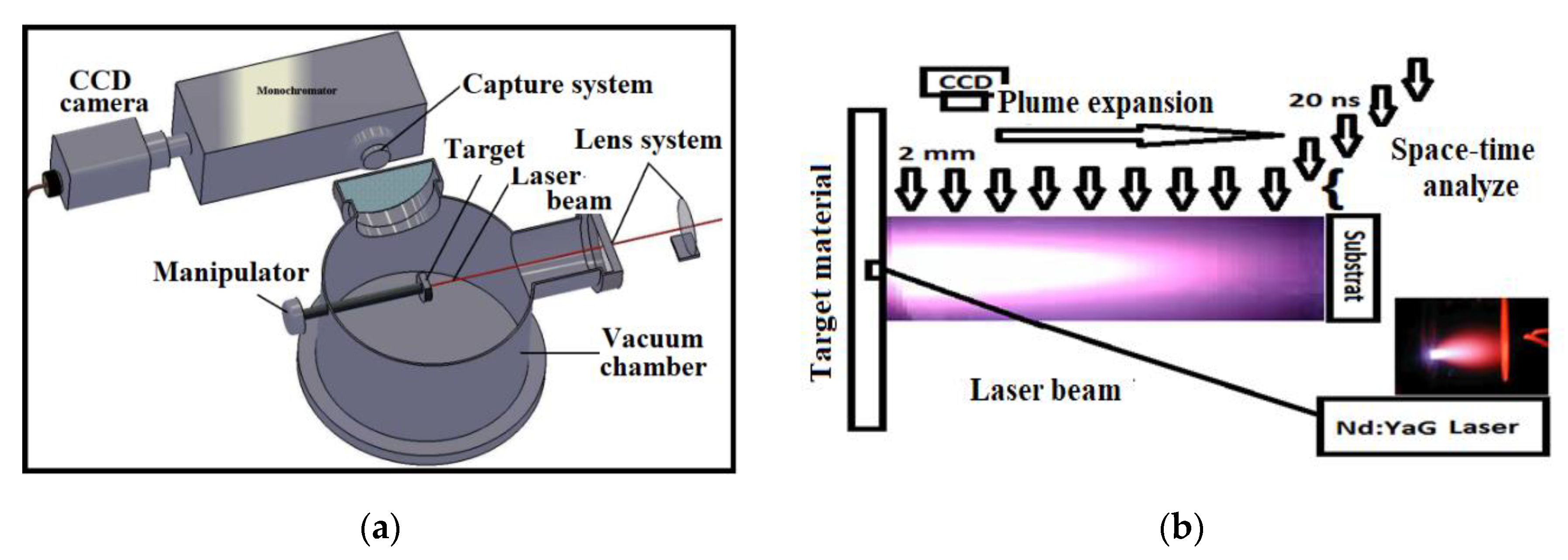
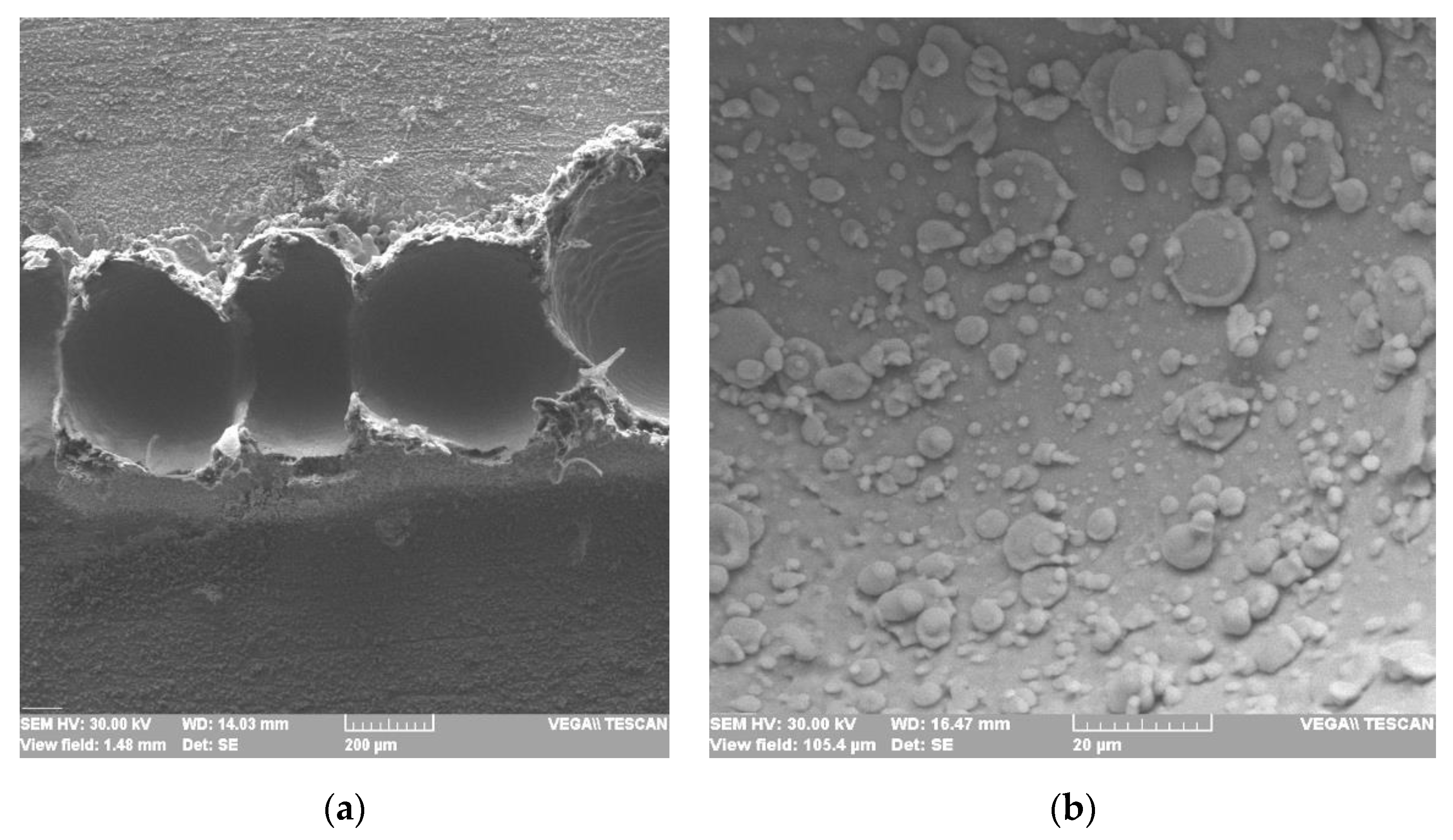

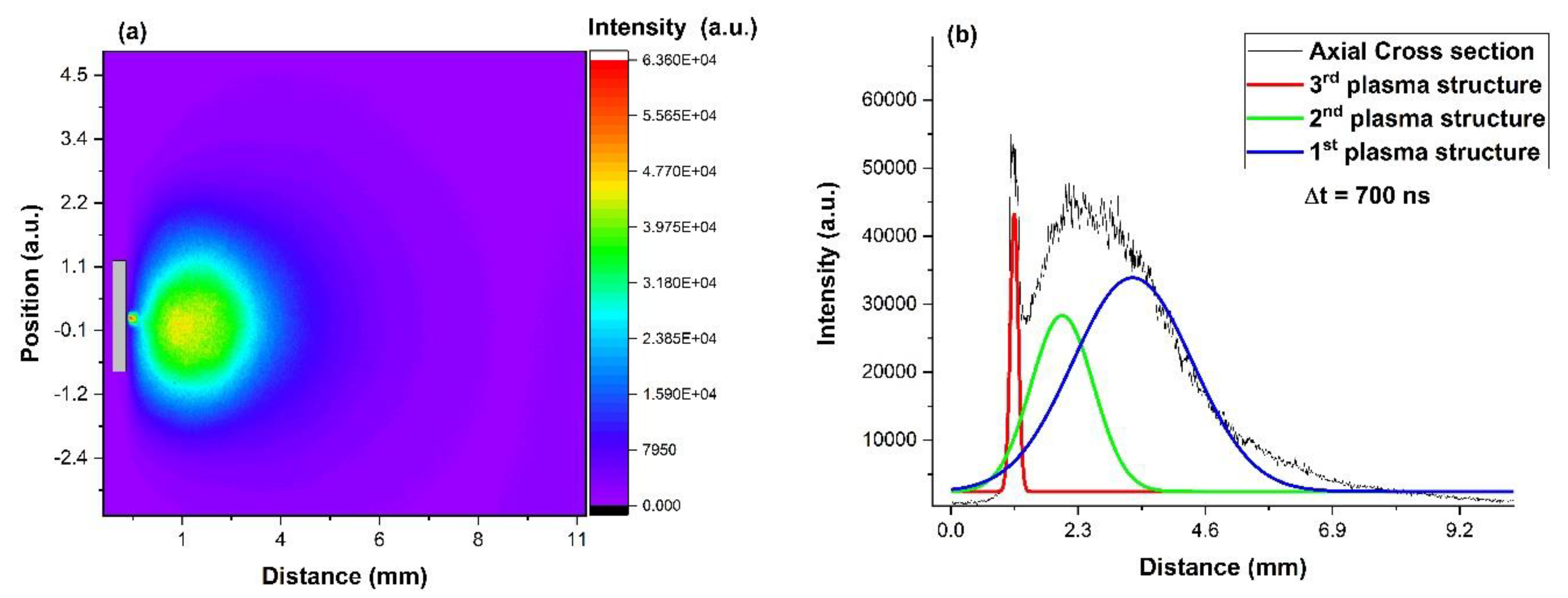
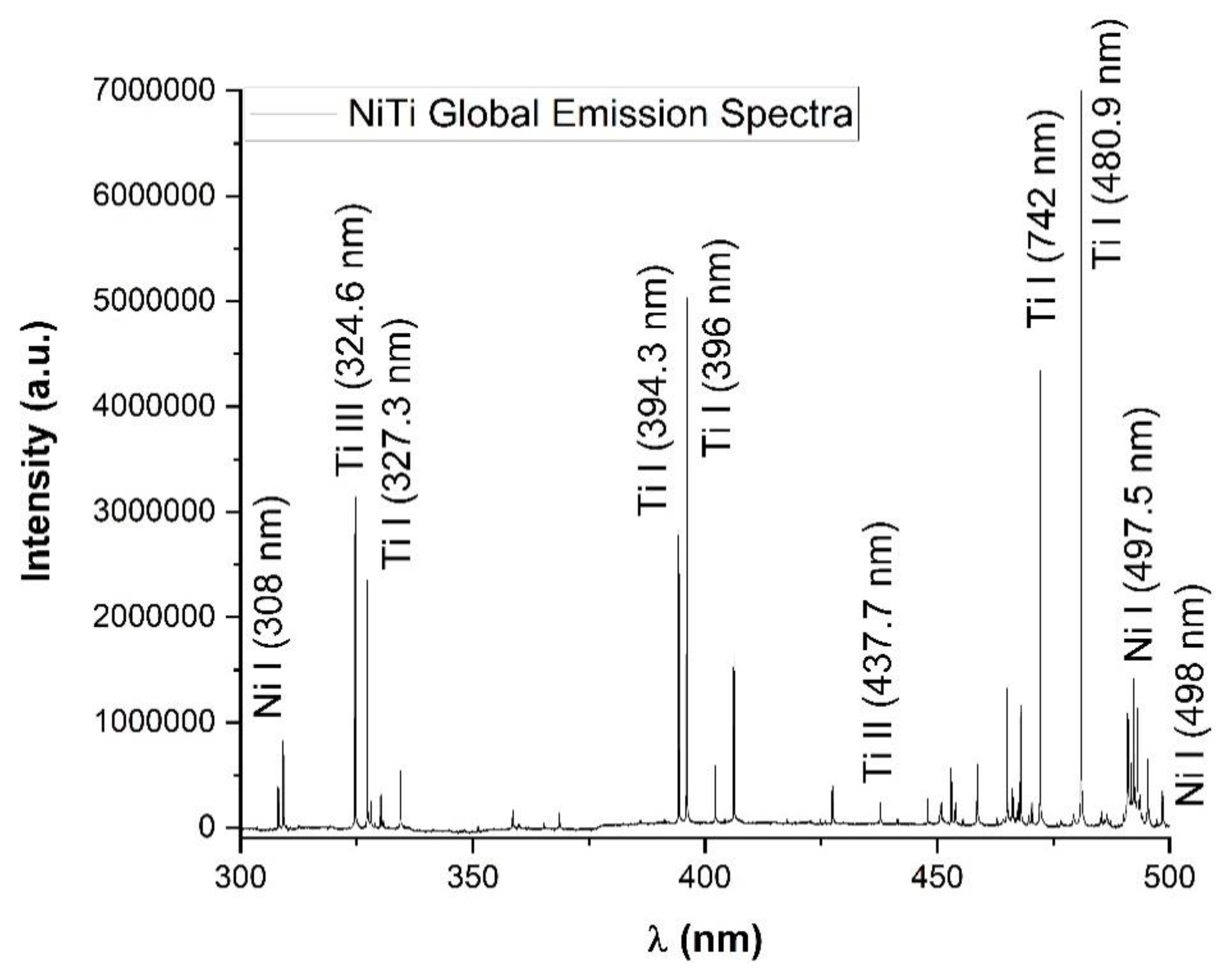
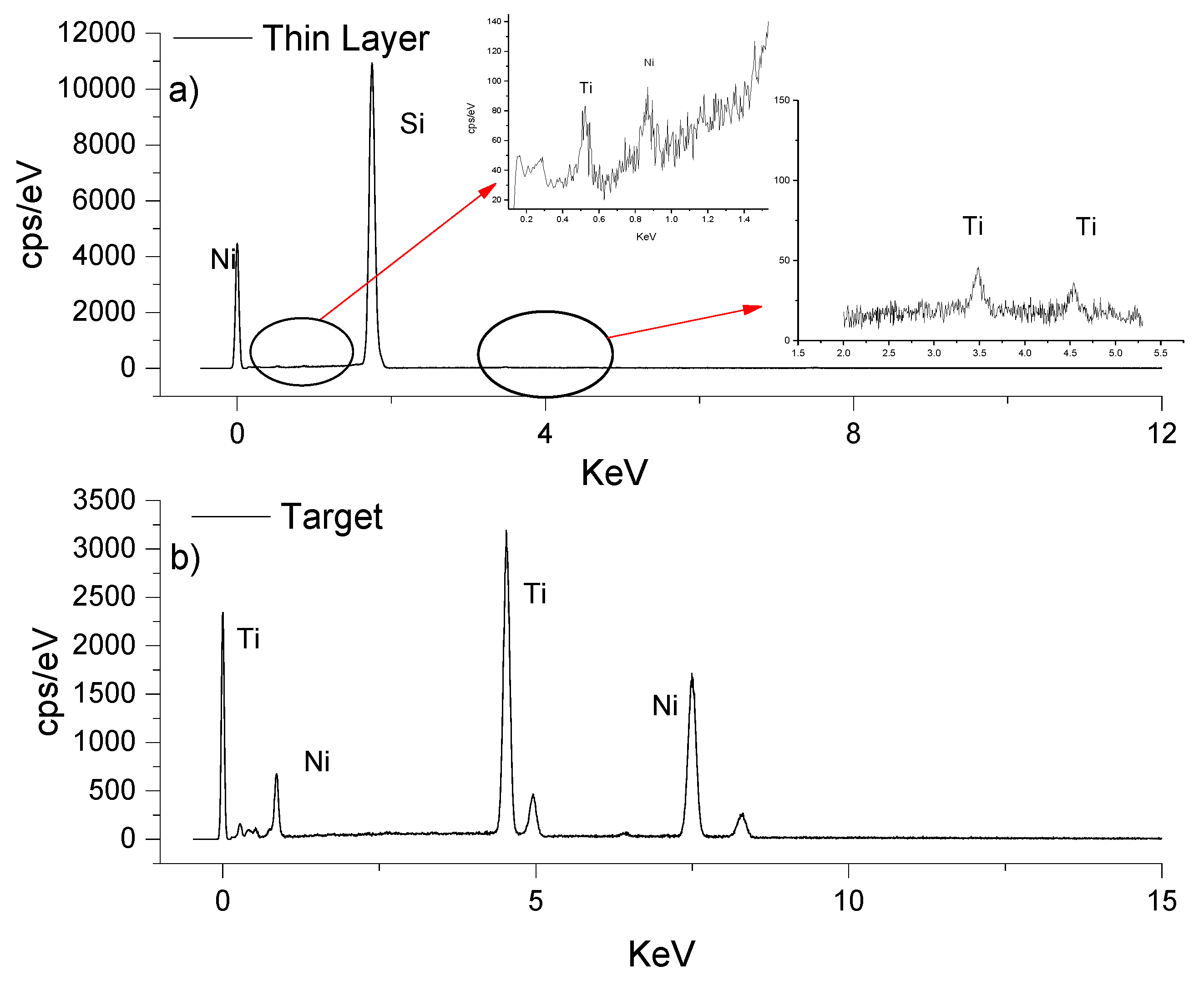
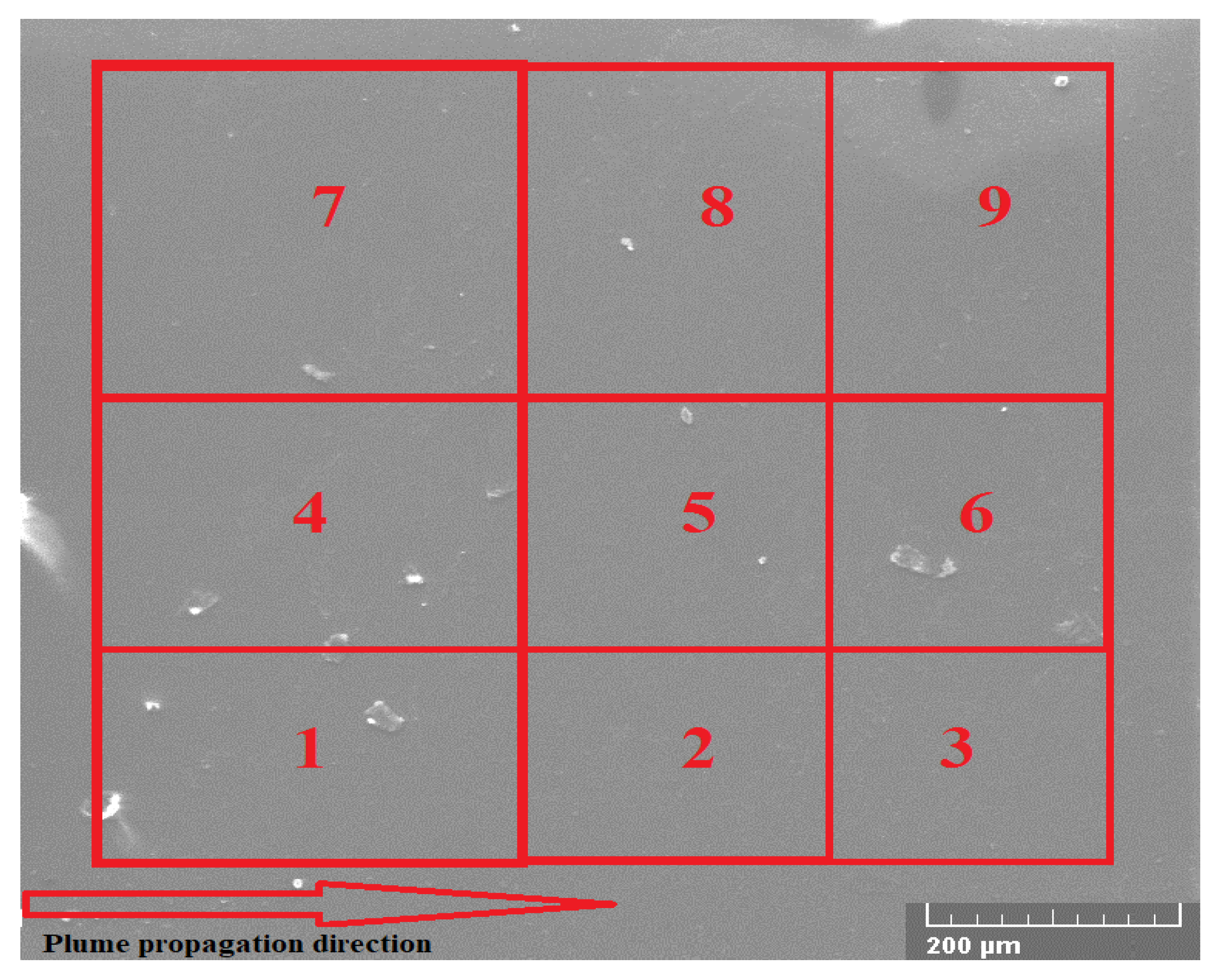
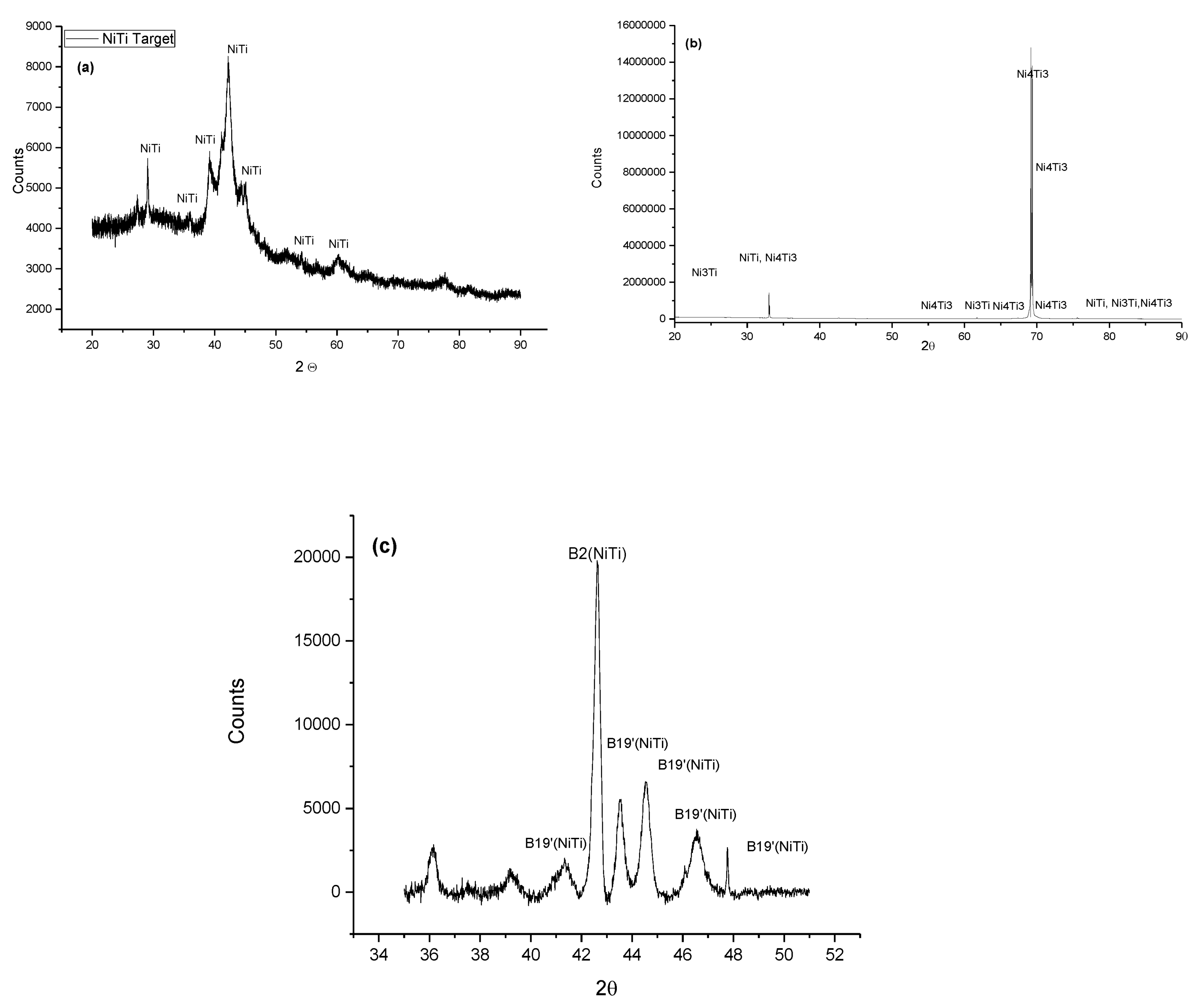
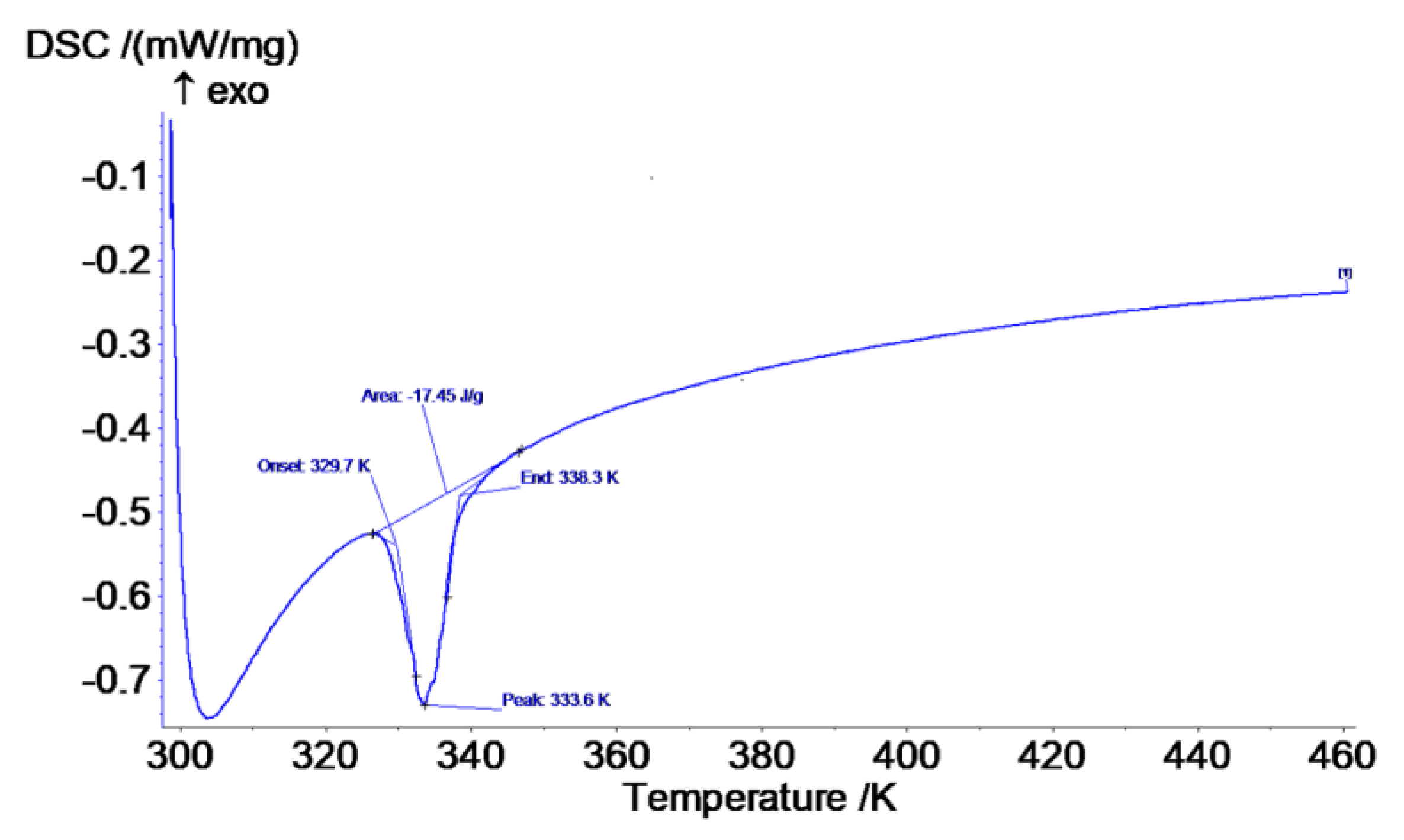
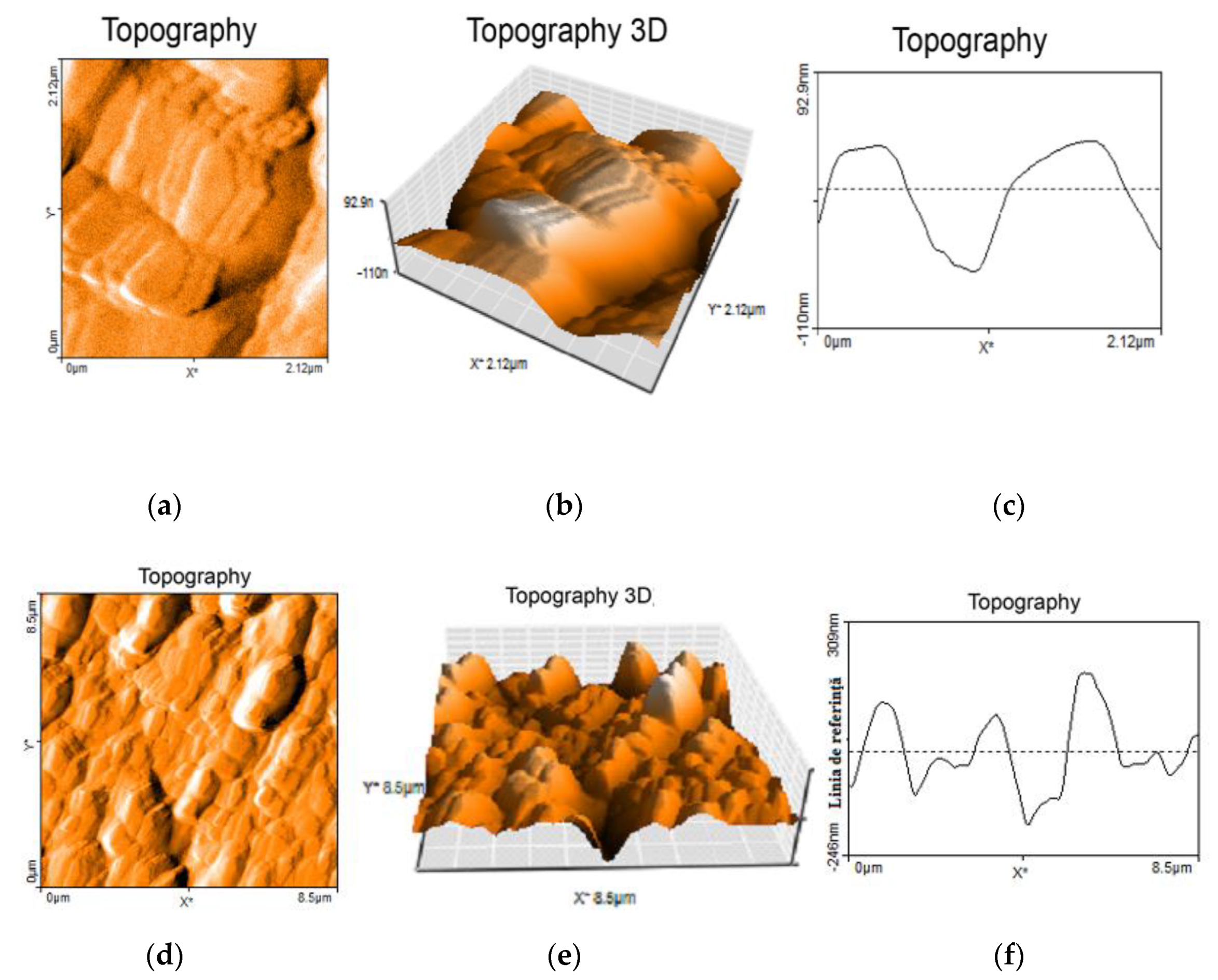
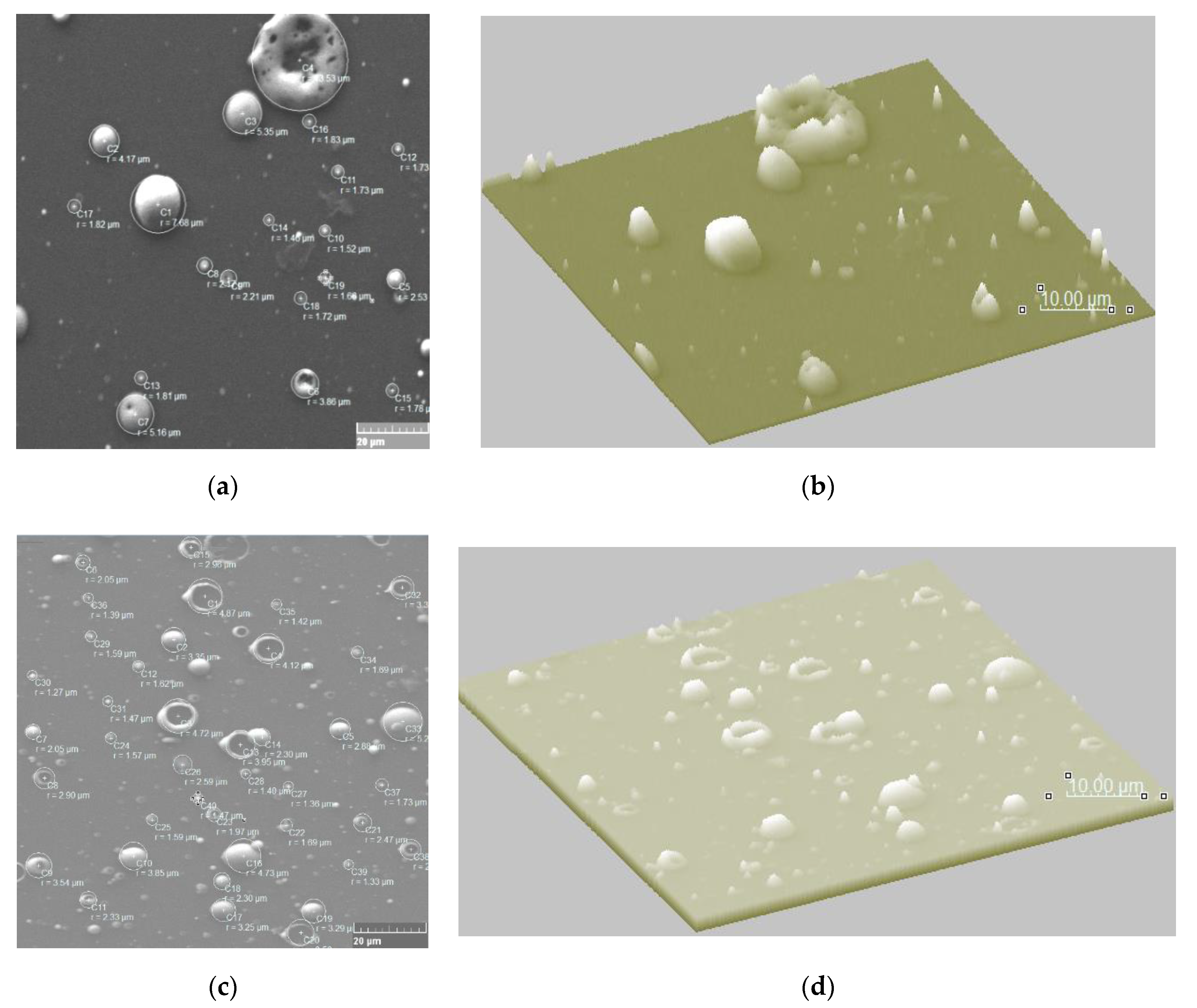
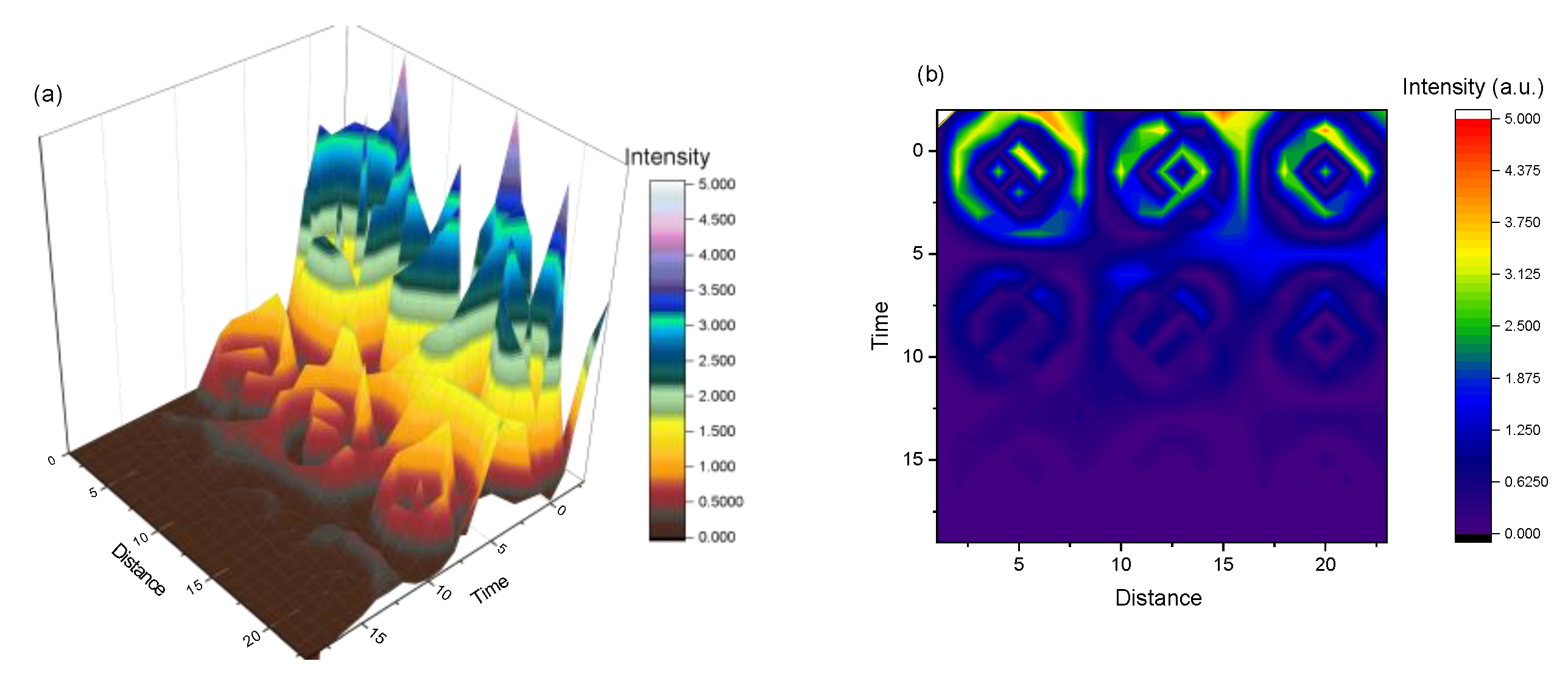
| Chemical Element | Target | Zone 1 | Zone 2 | Zone 3 | Zone 4 | Zone 5 | Zone 6 | Zone 7 | Zone 8 | Zone 9 | ||
|---|---|---|---|---|---|---|---|---|---|---|---|---|
| Sample B | Ni (accuracy 0.2%) | wt.% | 60.0 | 63.3 | 62.6 | 63.9 | 63.4 | 63.1 | 61.5 | 62.9 | 65.01 | 64.9 |
| at% | 55.01 | 58.4 | 57.7 | 59.2 | 58.6 | 58.2 | 56.6 | 57.9 | 60,25 | 60.2 | ||
| Ti accuracy 0.15%) | wt.% | 40.0 | 36.7 | 37.4 | 36.01 | 36.6 | 36.9 | 38.5 | 37.1 | 34.9 | 35.1 | |
| at% | 44.99 | 41.6 | 42.3 | 40.8 | 41.4 | 41.8 | 43.3 | 42.1 | 39.7 | 39.8 | ||
| Sample A | Ni (accuracy 0.2%) | wt.% | 60.0 | 61.3 | 60.9 | 58.7 | 60.1 | 58.74 | 58.1 | 58.2 | 59.6 | 57.3 |
| at% | 55.01 | 56.4 | 55.9 | 53.6 | 55.1 | 53.7 | 53.1 | 53.2 | 54.6 | 52.3 | ||
| Ti (accuracy 0.15%) | wt.% | 40.0 | 38.7 | 39.1 | 41.4 | 39.9 | 41.3 | 41.9 | 41.8 | 40.4 | 42.7 | |
| at% | 44.99 | 43.6 | 44.1 | 46.4 | 44.9 | 46.3 | 46.9 | 46.8 | 45.4 | 47.7 | ||
© 2020 by the authors. Licensee MDPI, Basel, Switzerland. This article is an open access article distributed under the terms and conditions of the Creative Commons Attribution (CC BY) license (http://creativecommons.org/licenses/by/4.0/).
Share and Cite
Cimpoesu, N.; Gurlui, S.; Bulai, G.; Cimpoesu, R.; Paun, V.-P.; Irimiciuc, S.A.; Agop, M. In-Situ Plasma Monitoring during the Pulsed Laser Deposition of Ni60Ti40 Thin Films. Symmetry 2020, 12, 109. https://doi.org/10.3390/sym12010109
Cimpoesu N, Gurlui S, Bulai G, Cimpoesu R, Paun V-P, Irimiciuc SA, Agop M. In-Situ Plasma Monitoring during the Pulsed Laser Deposition of Ni60Ti40 Thin Films. Symmetry. 2020; 12(1):109. https://doi.org/10.3390/sym12010109
Chicago/Turabian StyleCimpoesu, Nicanor, Silviu Gurlui, Georgiana Bulai, Ramona Cimpoesu, Viorel-Puiu Paun, Stefan Andrei Irimiciuc, and Maricel Agop. 2020. "In-Situ Plasma Monitoring during the Pulsed Laser Deposition of Ni60Ti40 Thin Films" Symmetry 12, no. 1: 109. https://doi.org/10.3390/sym12010109
APA StyleCimpoesu, N., Gurlui, S., Bulai, G., Cimpoesu, R., Paun, V.-P., Irimiciuc, S. A., & Agop, M. (2020). In-Situ Plasma Monitoring during the Pulsed Laser Deposition of Ni60Ti40 Thin Films. Symmetry, 12(1), 109. https://doi.org/10.3390/sym12010109









